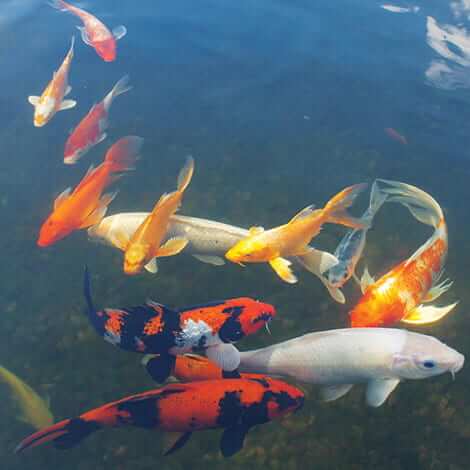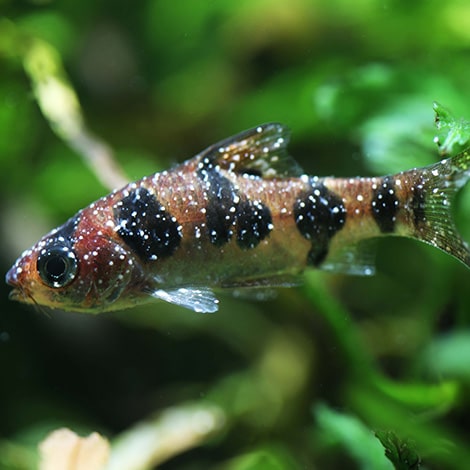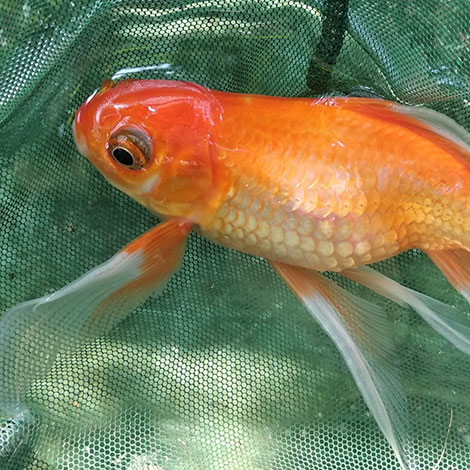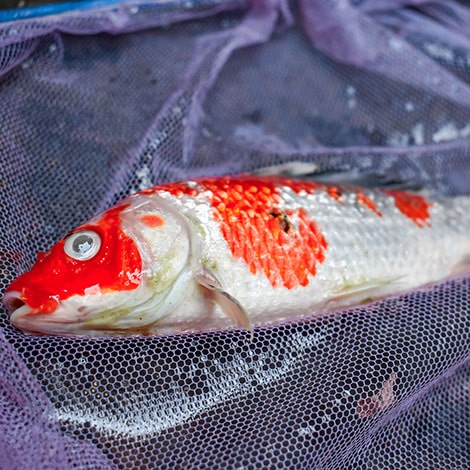Just like humans, a fish's immune system can also weaken from stress and environmental factors such as poor water quality and poor nutrition, making them susceptible to common fish diseases. There's nothing sadder than a sick fish--mainly when it's your friendliest koi or goldfish. Learn what to look for and how to care for your finned friends.
Warning Signs
Lack of appetite, open sores, flashing, rubbing, or gasping at the surface are all warning signs that your fish are under the weather.
- Inspect your fish for red sores on fins or mouths. These are signs of a bacterial infection.
- White spots or a cottony appearance are signs of a parasite or fungal infection.
- Watch for your fish gasping at the pond's surface, indicating signs of stress from a lack of oxygen.
Common Parasites
When present in the water, parasites, like anchor worms, ich, and fungi, can attach to the fish's body and irritate it. Fish can be seen "flashing" or rubbing against objects and have a sunken appearance.
- Anchor Worm: These white string-like worms and their larvae can be introduced to your pond when adding new fish or aquatic plants. Once the worms have attached to the fish's body, red sores or inflammation may appear at the attachment point. Tweezers are often used to remove the worms, followed by a treatment like KnockOut Plus or Microbe-Lift Anchor Worm.
- Ich: The white spot disease usually infects fish under much stress caused by pH fluctuations or rapid temperature changes. Along with flashing, fish may gasp for air with clamped fins at the surface or have pinhead white spots that look like white grains of sand. CrystalClear KnockOut Plus can treat the initial pond fish disease. At the same time, Pond Salt or MelaFix are often used to prevent secondary infection or when treating new fish in an isolation tank before being introduced to the pond.
- Fungus: Inspect your fish for gray or whitish fungus growths on the scales, giving the fish a cotton-like appearance. If only one fish shows signs of fungus, place them in an isolation tank and treat it with a fungus medication like KnockOut Plus.
Koi Bacterial Infections
Koi bacterial infections are usually a symptom of a more significant issue. Parasites, predators, and poor water conditions can lead to common infections like fin rot, mouth rot, and dropsy.
- Fin/Mouth Rot: Look for color fading and ragged or decaying tissue around the mouth or fins. The first step is to test the water and do a partial water change when water conditions are poor. Next, treat with WipeOut or other bacterial medications.
- Dropsy: Dropsy causes the kidneys to retain fluid and is hard to treat. Look for signs of protruding scales or bloating. Dropsy is often a secondary pond fish disease when the immune system is compromised, so prevention is vital. Place infected or new fish into an isolation tank with warm water (about 70-75ºF), pond salt, MelaFix, and vigorous aeration for treatment or prevention.
Other Diseases
Here are some other common fish illnesses and symptoms to watch for.
- Gill Disease: Often caused by poor water conditions and high ammonia levels, fish will have sunken eyes, loss of appetite, gasping for air at the surface, and will often lay at the bottom of the pond for long periods. Treatment will include an isolation tank with vigorous aeration and a mix of pond salt with MelaFix. After treatment, keep ammonia levels down with aeration, partial water changes, and water testing.
- Oxygen Deprivation: Seen in ponds without a sufficient aeration kit, chemical overdose, or overcrowding. Ponds with low oxygen levels may often cause fish to gasp for air at the surface or hang out by the waterfall. Add a bottom diffused aeration kit to circulate the entire pond to prevent this from happening.
- Pop Eye: Cloudy or red eyes are the first sign, but the most common symptom is when the eyes bulge out. Poor water conditions and trauma are common causes of Pop Eye. However, nutritional deficiency can also cause it in rare cases. Isolating fish with pond salt and vigorous aeration is the best treatment for cloudy eye in fish.
Reevaluate Your Routine
Routine maintenance, such as partial water changes, water testing, filtration, aeration, and population control, can prevent the most common fish diseases. We recommend to allow no more than 1-2 koi or 2-3 goldfish per 200 gallons of water for the best ecosystem.
Read More Articles
Why Water Changes Are Important
Causes of Low Oxygen
How Many Fish Can I Have?
Last Updated: October 20, 2023



